Wakasan (Los Angeles, CA) [2]
Wakasan
1929 Westwood Blvd, Los Angeles, CA 90025
310.446.5241
www.fooddigger.com/RestaurantDetail.aspx?id=21054 (FoodDigger, restaurant has no web site)
Sat 03/14/2009, 07:15p-10:00p
Unlike the sushi-focused Japanese restaurants I normally frequent, Wakasan serves up more rustic, home-style, izakaya-type fare. I'd been here before, but a friend of mine wanted to return, and I was game. The way to go at Wakasan is omakase, of which the restaurant offers four choices: $35, $55, $75, and $95. I didn't even know about anything but the $35 until recently, and as you might expect from me, I wanted to go all out and try the $95. The problem was that when we called, we were told that the $75 and $95 options usually require a week's notice, though it'd be possible to do them in one day. Not wanting to compromise the quality of the food (we were going in two days), we settled on the $55. Regarding my first visit, I wrote that the $35 omakase was a "downright steal" and that I "wouldn't feel out of place paying twice as much." It'd be interesting to see how much of an "upgrade" the $55 would represent.
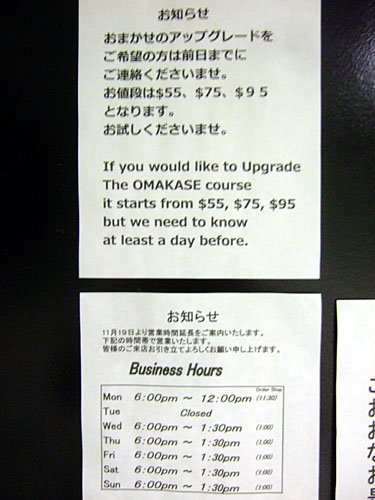
I could only find the various omakase choices posted on the bathroom door of all places. The restaurant could do a better job at advertising their menu options.
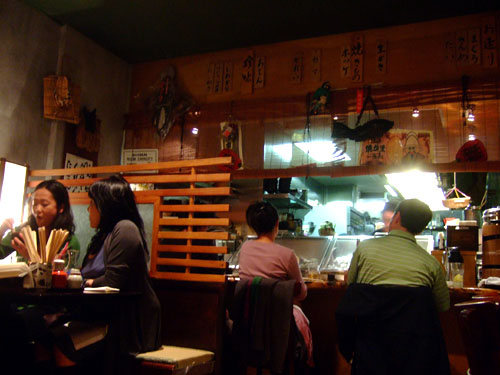
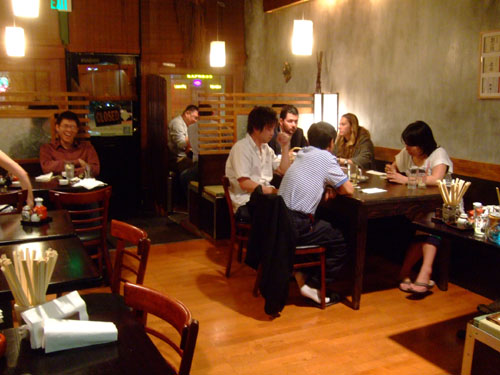
The dining room is small, with about eight tables of varying sizes and seating along the walls. The space doesn't feel cramped however, but rather charming and inviting, with quaint touches abound.
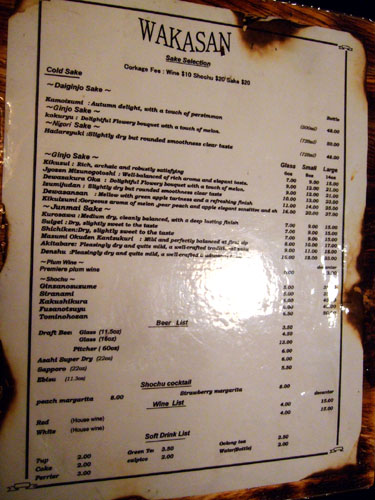
Wakasan's drink list offers up a good selection of sake, as well as shochu and beer. Click for a larger version.
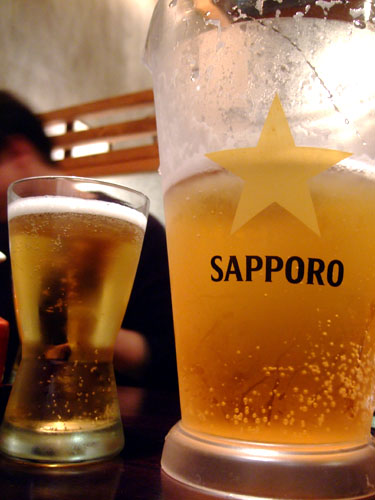
To start things off, we decided on a pitcher (60oz) of Sapporo Draft [$13], basically your typical Japanese rice lager. Sapporo sold in the US is generally brewed by in Canada (by Sleeman), but I wonder if that was the case here, as the beer tasted somewhat better than normal (or maybe's it was just due to it being on tap).
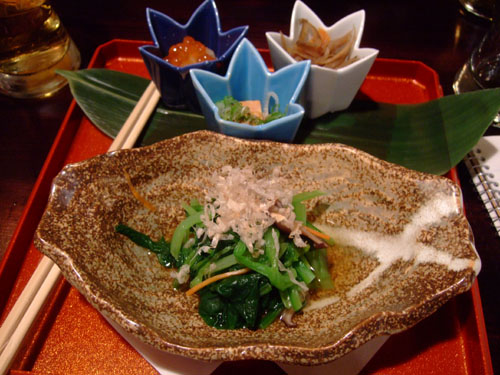
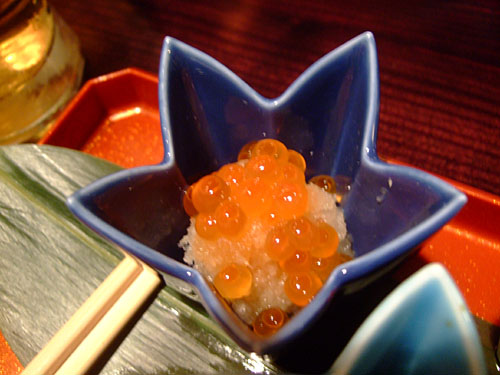
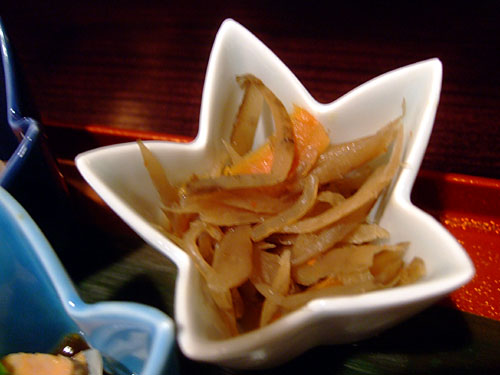
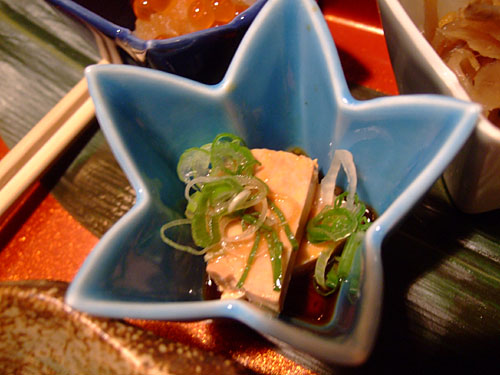
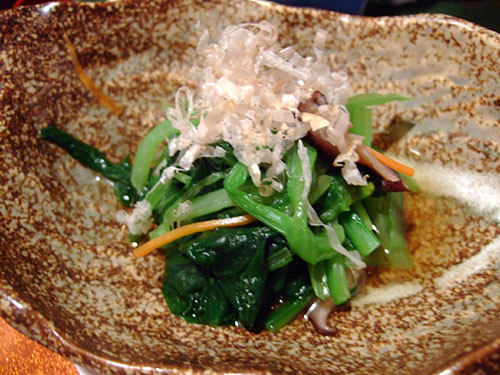
1: Appetizer Quartet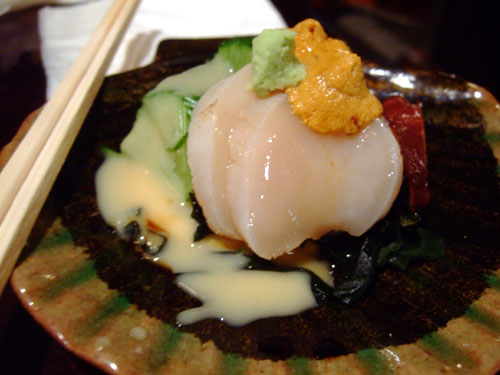
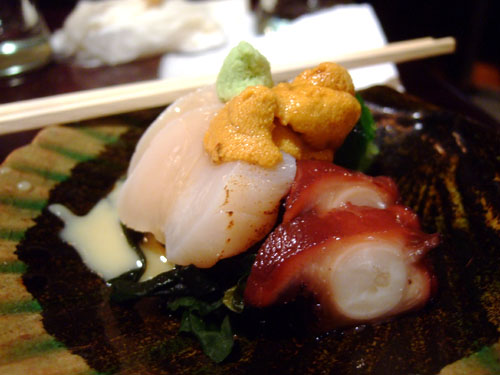
2: Sunomono
I believe this would be considered a sunomono, or vinegar-marinated dish (lemon and mirin were used as well I believe). The ingredients were hotate, tako, uni, wakame seaweed, and cucumber. I first tried the scallop; it had a great texture, but the taste was a bit too fishy; fortunately the wasabi helped temper this. Next was the octopus, surprisingly soft, with a rich flavor alternating between sweet and savory--not bad. The uni, meanwhile, was good on its own, excellent with the wasabi. Overall, this was a middling course.
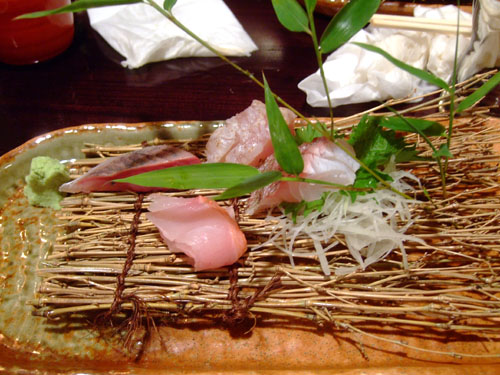
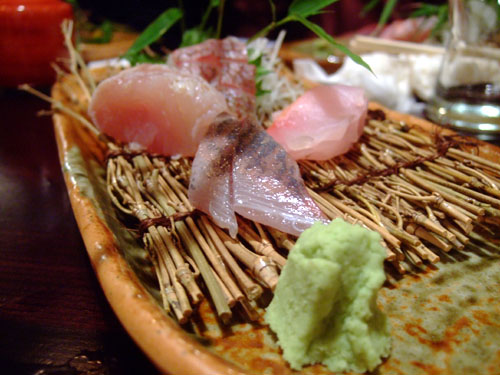
3: Sashimi
I loved the beautiful, rustic presentation of the sashimi here. We were given binnaga maguro (albacore), hamachi (yellowtail), and two types of tai (snapper). I first tasted the albacore; it had a distinctly creamy texture, uncharacteristic of the fish, but its flavor was curiously absent; the soy was a necessity. Next was the yellowtail, which I found much more flavorful. It had a noticeable, but not overwhelming fishiness to it, and exhibited a soft, but not overly fatty consistency--pretty good. As for the two types of snapper, the first was alfonsino, a.k.a. Tasmanian snapper or red bream. It was my favorite of the bunch, with a wonderfully crisp, snappy body paired with a mild, delicate flavor. The other tai was identified solely as being "from Japan." It wasn't nearly as good as the alfonsino, being tough, stringy, and nearly flavorless--soy didn't help much.
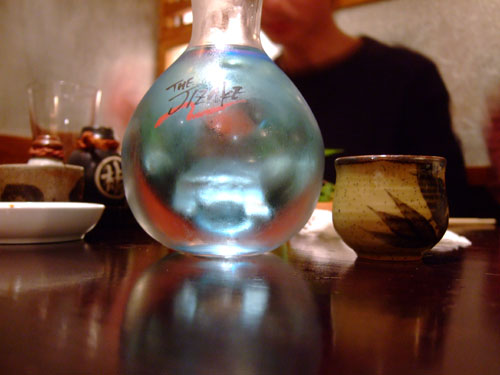
Once we dispensed with the beer, we moved on to sake: a large (14oz) Dewazakura Oka [$21]. Turns out they ran out of the large carafes, and instead gave us two small ones (actually not a bad deal since that's 2x8oz=16oz). The Dewazakura Oka is a ginjo-grade (rice polished to less than 60%) sake from Yamagata Prefecture. It was a very good, though not outstanding sake, with a lovely floral nose and juicy hints of fruit on the palate (no cherry though, despite the name "Oka" meaning "cherry blossom"). Soft, slightly viscous, with a smooth finish.
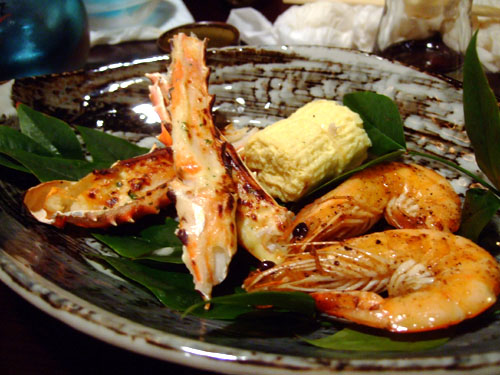
4: Kani, Ebi, Tamago
Though a relatively straightforward course of grilled crab legs and shrimp, this was easily my favorite of the meal. I first tasted the crab; wonderfully tender, the legs had their signature sweetness in spades, accented by a bit of brininess. This was perfectly contrasted with the savory flavor imparted by the grilling. The end result was fantastic. As good as the crab was, the shrimp was even better, with the natural flavor of the crustaceans highlighted by the use of garlic and spice, giving the shrimp an almost Chinese flavor. It was simply the best shrimp I've had in recent memory. To finish things off, the egg omelet was a relatively mild contrast to the power of the rest of the dish, but even it was augmented by a bit of savory eel stuffing--very nice.
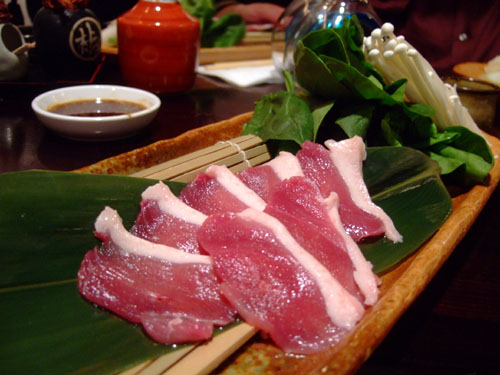
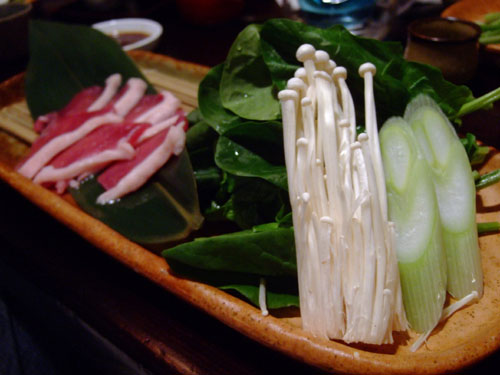
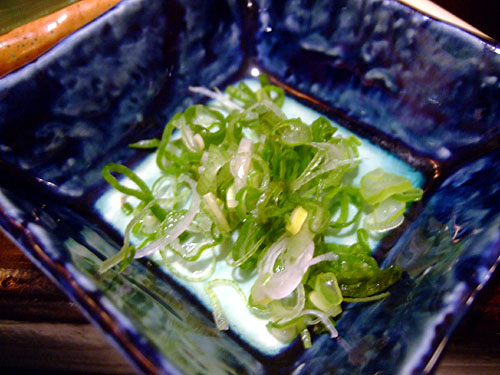
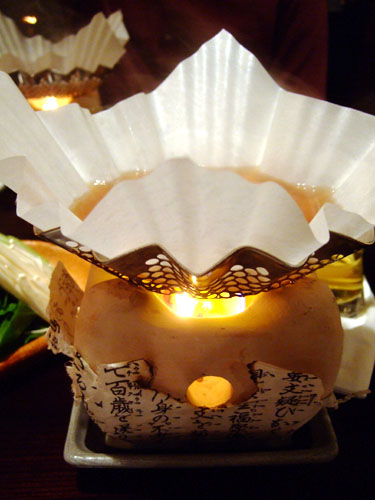
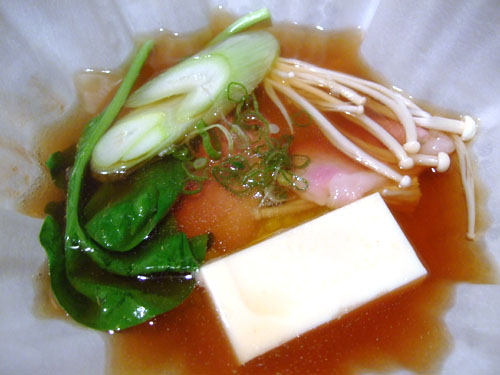
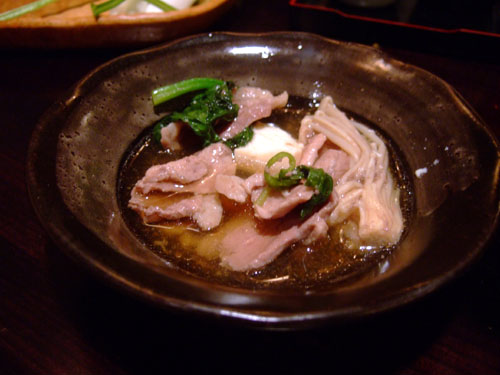
5: Duck Nabemono
Nabemono, or nabe, can be thought of as a hot pot, along the lines of a sukiyaki or shabu shabu. Here, the featured ingredients were beautiful slices of ruby red duck, complemented with greens, tofu, enoki mushroom, leek, and scallion. The cooking vessel itself was powered by a petroleum-based solid fuel, and heated an intense, savory broth (I'm thinking soy and/or dashi based) held in a paper container; the whole setup was similar to what I've had at Urasawa before. We had great fun cooking the various items, and I really savored the interplay of all the different ingredients, trying out different combinations. The duck itself took on almost foie gras-like flavor, steeped with the rich flavor of the broth. A delicious, heartwarming dish.
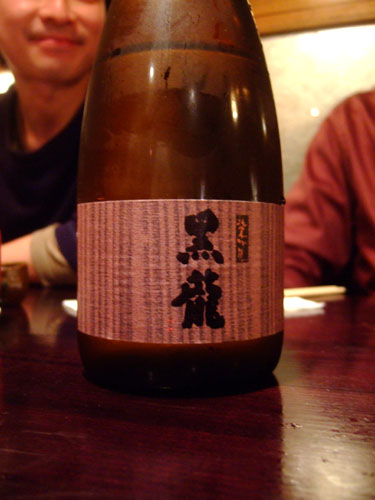
The last and final beverage was a bottle of Kokuryu [$50], a junmai ginjo from Fukui Prefecture. I think this was actually mistakenly listed as a daiginjo; the seimai-buai, or rice polishing ratio, is only 55%, above the 50% threshold for daiginjo. In any case, this was quite a different sake than the Dewazakura Oka above. It wasn't as floral or fruity, but gave hints of spice, cocoa, and salt. Interesting and complex--the only problem was that the finish was a bit too hot for me.
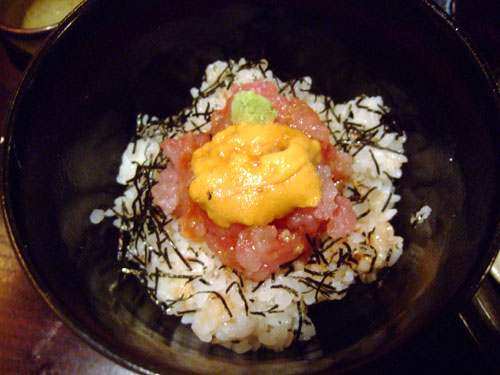
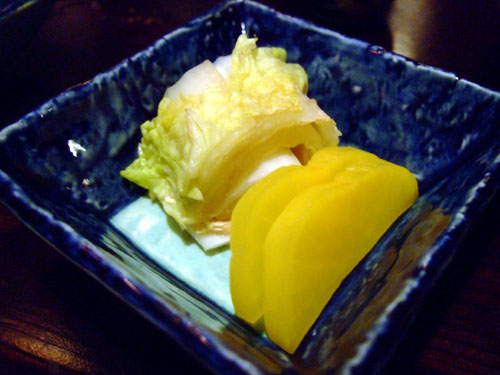
6: Uni-Maguro Don
This was a bowl of nori-infused rice, topped with tuna, uni, and wasabi. The lush, fatty tuna and sea urchin were great on their own--creamy, luxurious, decadent--but even better when accented by the spicy tang of wasabi. They were tempered by the rice, which was slightly sticky, and embedded with a nori, giving it an absolutely delightful seaweed flavor. This was served with pickles (daikon and cabbage), which added a lovely sour crunch to complement the dish.
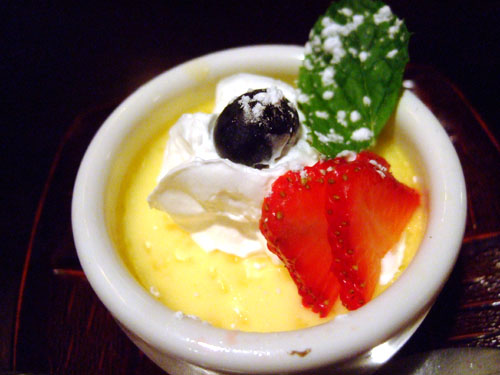
7: Cream Pudding
This was similar flavor-wise to a crème brûlée, but without the hard caramelized top. The custard had a rich, creamy flavor that was quite in-your-face; its intensity was fortunately mitigated by the fruit. Not a bad dessert, but I would've liked something more inventive.
All in all, this was a solid meal, but not necessarily better than the $35 version. Indeed, the ingredients were more luxurious, and the preparations more involved, but the whole experience wasn't really more satisfying. And let's not forget that we only had seven courses here, versus the 13 last time. Nevertheless, I do want to return sometime and see how the $95 version compares.
1929 Westwood Blvd, Los Angeles, CA 90025
310.446.5241
www.fooddigger.com/RestaurantDetail.aspx?id=21054 (FoodDigger, restaurant has no web site)
Sat 03/14/2009, 07:15p-10:00p
Unlike the sushi-focused Japanese restaurants I normally frequent, Wakasan serves up more rustic, home-style, izakaya-type fare. I'd been here before, but a friend of mine wanted to return, and I was game. The way to go at Wakasan is omakase, of which the restaurant offers four choices: $35, $55, $75, and $95. I didn't even know about anything but the $35 until recently, and as you might expect from me, I wanted to go all out and try the $95. The problem was that when we called, we were told that the $75 and $95 options usually require a week's notice, though it'd be possible to do them in one day. Not wanting to compromise the quality of the food (we were going in two days), we settled on the $55. Regarding my first visit, I wrote that the $35 omakase was a "downright steal" and that I "wouldn't feel out of place paying twice as much." It'd be interesting to see how much of an "upgrade" the $55 would represent.

I could only find the various omakase choices posted on the bathroom door of all places. The restaurant could do a better job at advertising their menu options.


The dining room is small, with about eight tables of varying sizes and seating along the walls. The space doesn't feel cramped however, but rather charming and inviting, with quaint touches abound.

Wakasan's drink list offers up a good selection of sake, as well as shochu and beer. Click for a larger version.

To start things off, we decided on a pitcher (60oz) of Sapporo Draft [$13], basically your typical Japanese rice lager. Sapporo sold in the US is generally brewed by in Canada (by Sleeman), but I wonder if that was the case here, as the beer tasted somewhat better than normal (or maybe's it was just due to it being on tap).





1: Appetizer Quartet
- Sansai - The first item I tried were the simmered greens (or sansai--"mountain vegetable"), flavored with bonito (skipjack tuna) broth, katsuobushi (dried bonito shavings, specifically the thinner hanakatsuo variety), and shiitake mushroom. The sansai had a slightly crunchy consistency, not unlike spinach. Its mild flavor was contrast sharply by the smoky, savory fishiness of the bonito. Very similar to the first dish on my last visit.
- Ankimo - I then took a bite of the ankimo, or monkfish liver. Paired with scallion and a sweet ponzu sauce, it reminded me of the superb ankimo I had at Shibucho. It had a great, firm texture and its mild, delicate flavor was deftly complemented by the sweet ponzu and zest of the scallion. Very nice--my favorite of the quartet.
- Kinpira Gobo - Gobo, also known as burdock, is root vegetable known for its mildly sweet, vegetal flavor and crunchy texture. Kinpira gobo is shredded burdock and carrot, traditionally cooked with soy sauce, mirin (sweet rice wine), and sugar. I'm not usually a fan of burdock, but thought that this preparation was quite tasty, with the sweetness of the root taking center stage.
- Ikura - The salmon roe was served over daikon oroshi, or grated daikon radish. My dining companions didn't care for this, though I didn't have a problem with it. I felt that the daikon tempered the brininess of the roe, but they found it overpowering.


2: Sunomono
I believe this would be considered a sunomono, or vinegar-marinated dish (lemon and mirin were used as well I believe). The ingredients were hotate, tako, uni, wakame seaweed, and cucumber. I first tried the scallop; it had a great texture, but the taste was a bit too fishy; fortunately the wasabi helped temper this. Next was the octopus, surprisingly soft, with a rich flavor alternating between sweet and savory--not bad. The uni, meanwhile, was good on its own, excellent with the wasabi. Overall, this was a middling course.


3: Sashimi
I loved the beautiful, rustic presentation of the sashimi here. We were given binnaga maguro (albacore), hamachi (yellowtail), and two types of tai (snapper). I first tasted the albacore; it had a distinctly creamy texture, uncharacteristic of the fish, but its flavor was curiously absent; the soy was a necessity. Next was the yellowtail, which I found much more flavorful. It had a noticeable, but not overwhelming fishiness to it, and exhibited a soft, but not overly fatty consistency--pretty good. As for the two types of snapper, the first was alfonsino, a.k.a. Tasmanian snapper or red bream. It was my favorite of the bunch, with a wonderfully crisp, snappy body paired with a mild, delicate flavor. The other tai was identified solely as being "from Japan." It wasn't nearly as good as the alfonsino, being tough, stringy, and nearly flavorless--soy didn't help much.

Once we dispensed with the beer, we moved on to sake: a large (14oz) Dewazakura Oka [$21]. Turns out they ran out of the large carafes, and instead gave us two small ones (actually not a bad deal since that's 2x8oz=16oz). The Dewazakura Oka is a ginjo-grade (rice polished to less than 60%) sake from Yamagata Prefecture. It was a very good, though not outstanding sake, with a lovely floral nose and juicy hints of fruit on the palate (no cherry though, despite the name "Oka" meaning "cherry blossom"). Soft, slightly viscous, with a smooth finish.

4: Kani, Ebi, Tamago
Though a relatively straightforward course of grilled crab legs and shrimp, this was easily my favorite of the meal. I first tasted the crab; wonderfully tender, the legs had their signature sweetness in spades, accented by a bit of brininess. This was perfectly contrasted with the savory flavor imparted by the grilling. The end result was fantastic. As good as the crab was, the shrimp was even better, with the natural flavor of the crustaceans highlighted by the use of garlic and spice, giving the shrimp an almost Chinese flavor. It was simply the best shrimp I've had in recent memory. To finish things off, the egg omelet was a relatively mild contrast to the power of the rest of the dish, but even it was augmented by a bit of savory eel stuffing--very nice.






5: Duck Nabemono
Nabemono, or nabe, can be thought of as a hot pot, along the lines of a sukiyaki or shabu shabu. Here, the featured ingredients were beautiful slices of ruby red duck, complemented with greens, tofu, enoki mushroom, leek, and scallion. The cooking vessel itself was powered by a petroleum-based solid fuel, and heated an intense, savory broth (I'm thinking soy and/or dashi based) held in a paper container; the whole setup was similar to what I've had at Urasawa before. We had great fun cooking the various items, and I really savored the interplay of all the different ingredients, trying out different combinations. The duck itself took on almost foie gras-like flavor, steeped with the rich flavor of the broth. A delicious, heartwarming dish.

The last and final beverage was a bottle of Kokuryu [$50], a junmai ginjo from Fukui Prefecture. I think this was actually mistakenly listed as a daiginjo; the seimai-buai, or rice polishing ratio, is only 55%, above the 50% threshold for daiginjo. In any case, this was quite a different sake than the Dewazakura Oka above. It wasn't as floral or fruity, but gave hints of spice, cocoa, and salt. Interesting and complex--the only problem was that the finish was a bit too hot for me.


6: Uni-Maguro Don
This was a bowl of nori-infused rice, topped with tuna, uni, and wasabi. The lush, fatty tuna and sea urchin were great on their own--creamy, luxurious, decadent--but even better when accented by the spicy tang of wasabi. They were tempered by the rice, which was slightly sticky, and embedded with a nori, giving it an absolutely delightful seaweed flavor. This was served with pickles (daikon and cabbage), which added a lovely sour crunch to complement the dish.

7: Cream Pudding
This was similar flavor-wise to a crème brûlée, but without the hard caramelized top. The custard had a rich, creamy flavor that was quite in-your-face; its intensity was fortunately mitigated by the fruit. Not a bad dessert, but I would've liked something more inventive.
All in all, this was a solid meal, but not necessarily better than the $35 version. Indeed, the ingredients were more luxurious, and the preparations more involved, but the whole experience wasn't really more satisfying. And let's not forget that we only had seven courses here, versus the 13 last time. Nevertheless, I do want to return sometime and see how the $95 version compares.
15 Comments:
The Duck Nabemono looks amazing and what a great deal!
I count 14 courses. During my meal, we had 13 dishes if you count the original course of your 4 dishes as 4 dishes and not 1 course. This is how I translated my experience. And honestly, although yours only looks marginally more luxurious than my experience, the dishes as a whole look more to my liking. I am a monk fish liver ho. Beautiful review.
Jo: Yeah that nabe had some of the most beautiful looking duck I've seen. You know, despite "complaining" a bit, it is still quite a deal, even at $55.
Liz: Thanks Liz. I think you need to "upgrade" next time you're here. ;) I'm assuming you're getting 14 courses by counting course 1 as 4, course 3 as 4, and course 6 as 2. My first visit would be 15 using that standard, but it does even things out a bit I suppose.
My fellow blogger over at Rock and Dinner Roll is a semi-weekly regular here. The few times I've come, I haven't heard about the upgraded menu, and neither has he, as far as I know. We did know that there were a couple ask-in-advance items, though. We'll have to upgrade next time and put a review up on the blog. Keep up the good work!
That a regular customer doesn't know about the omakase levels at Wakasan is a testament to how they really need to advertise it better.
I'd definitely be curious to see a review of the $95 option!
I also didn't know about the upgraded menus. They seem to be so secretive about their menu items, especially to non-Japanese speakers. If I was coming to Wakasan though, I would be looking for more of the homestyle simple foods thats could probably be covered by $35
This is the first I've heard of anything other than the $35 omakase meal served at Wakasan. While the $55 version looks great, I'd want to try the $35 version there and work my way up.
I agree with you with the lack of marketing on the other choices of omakase. I presume they prefer the eaters to first try the basic version first, then go upward?
I just ate there last night. While the omakase is tasty, and I have infact had the more expensive version as well as the $35, I prefer to order of the standard menu. Wakasan and his son Taku who run's the front of the house are always coming up with delicious dishes depending on what they have in fresh daily. A rundown from last night:
Agedashi Tofu with Japanese Eggplant
Tai (red snapper from the sea of japan) Sashimi
Tsukune (Chicken Meatballs) with raw Jidori egg yolk to dip in.
Simmered Fluke with Dikon and Sansai
I encourage everyone to order from the daily menu as well as the omakase. Both are very enjoyable.
Aaron: Agree about the menu items. On my first visit, we asked for an a la carte menu, and it was written entirely in Japanese! I'd have been totally flummoxed had we not had a native speaker.
Danny: My guess is that they assume that most diners wouldn't want to spend the extra money, or wouldn't appreciate the difference. Or, they want to limit the pricier options since they're more difficult to prepare. It's not a bad idea to work your way up though.
rockanddinnerroll: It's nice to have a comment from a Wakasan regular. I'd be interested in ordering off the menu as well, but I can't read it. How do you get around this?
They do have a full English menu. Just ask for it. It's strange that they didn't offer one to you. Most of what I know about the menu at Wakasan SI've learned by watching and asking. All this talk of wakasan makes me want to go back tonight...
Ah thanks. I'll be sure to specify the English menu next time.
BTW, I just came back tonight from another great meal at Urasawa. Definitely try it sometime if you haven't been!
Just curious Kevin, how many times have you been to Urasawa? And does the menu/food vary each time you go? Also, with all these reviews, what's your overall #1 place to go eat at?
I've been four times; the fourth visit will be posted in the near future. The menu does change somewhat, as it is adjusted to reflect the use of seasonal ingredients. It's my #1 spot.
kevin I just posted my recent wakasan trip on my blog http://rockanddinnerroll.blogspot.com i think it should help shed some light on what happens at wakasan.
Just read your post on Wakasan. It was great to see the place from an "insider's" perspective.
Post a Comment
Subscribe to Post Comments [Atom]
<< Home